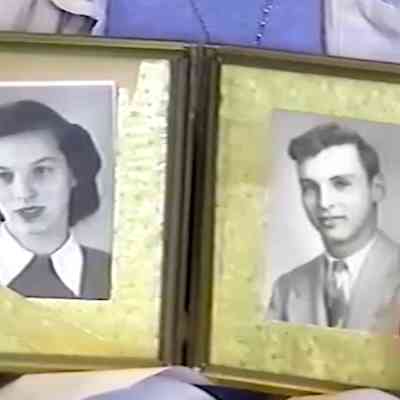Jim and Peggy Boyce on growing up, marriage and family in the '60s
Name/Title
Jim and Peggy Boyce on growing up, marriage and family in the '60sEntry/Object ID
2024.41.004Scope and Content
Video recording of Margaret "Peggy" Boyce and James Boyce III talking about their Chicago-based fathers both meeting and marrying local girls and attempting to live on self-sustaining farms during the Depression, their childhoods, school days, courting, and making ends meet in Saugatuck in the 1960s. The May 21, 2003 interview, conduced by Judy Mauger, happened at the Boyce family home at 275 North Street in Saugatuck. One of the first questions from Mauger was how the town reacted to "gypsies" that temporarily camped at the bottom of the dune north of Goshorn Lake. Born in Gibson, Jim worked as a "grease monkey" at Dicky Newnham/Ihle's Shell station, for Force's Florist "where township office is now" under John Kluster, and at Montgomery Ward and Goodyear Tire in Holland. He worked with Harold Johnson at Saugatuck Marine (Pier Marina) and in 1961 they purchased swampy land from Frank Sewers to build Saugatuck Yacht Service with investment by Bob Weller and Roger Cruise of Battle Creek. Jim claimed he and Harold drove most of the local piles and seawall then. He shared lively stories of being a police officer during the "hot town" era along with Hilton Brown, Bob Breckenridge, Mort Herbert, Gordon Alderink, Harold Whipple, Joe Dempski, Larry Brooks, Harry Newmham and Justice of the Peace Junkerman. Jim also told stories from his time as Gibson Church and Saugatuck Congregational Church deacon, how to drive from Gibson to Glenn (M11?) before the Blue Star Highway was built, his chemist father's inventions including Gold Dust Scouring Cleanser and relationship to Dorr Felt, meeting Peg while washing dishes at Plummer's Restaurant, his 1928 Model A Roadster pickup truck, tensions between commercial fishermen and pleasure boaters, and observed improvement in river water quality (no strawberries or celery leaves floating by) Peg was born at Saugatuck's first hospital (behind Dr. Walker's office) and lived in the drafty, scrap-wood "Buffalo House" at 526 Butler Street until she was 9 years old. Peg mentioned how once the Morgan Ice Company provided clean, hard ice made from city water, the Canara's Ice House, behind the Twin Gables, when out of business. A former teacher and school board member, Peg shared her knowledge of teacher's salaries and working conditions before and after "Master Contract" unionization and consolidation and her personal memories of Saugatuck school, Superintendent L.H. Waugh and the teaching staff. She recounted the challenges of raising a large family including working at Coral Gables from 6pm to 2am to earn cash and take home leftover roast bones for "Il Forno stew." Peg told how she came to be the 1959 Mrs. Michigan State Fair, how she went back to school to earn an art education degree and teach at West Ottawa High School for 20+ years. Places mentioned include the David Webster family farm on Silver Lake, Saugatuck telephone exchange, Flint's store, Sessions IGA, A+P grocery, the Big Pavilion, Kramer's Feed Mill in Douglas, Jager Orchard, Gibson Church, Gibson School, Green and Howard Pennant Company, and the early days of the Red Barn Theatre under Paul Steward Graham, Events mentioned include the Big Pavilion fire (Jim was on of the first on scene), Thursday night beach parties with the Brittain, Funk, Graves and Viets families and the decimation of the Boyce family farm by the 3 April 1956 tornado The interview concludes with a tour of artwork hanging in the house and a view of Jim's 1928 Model A Roadster.Collection
Family History, Police, sheriff and law enforcement, Education and schools, Weather, extreme, Artists, Childhood, 1870 Fruit growing, farming, agricultureCataloged By
Winthers, SallyAcquisition
Accession
2024.41Acquisition Method
Found in CollectionCredit Line
To view this recording, scroll down to the bottom of this entry and click the blue web link. This video was created by Saugatuck-Douglas History Center volunteers or was donated to the Center in a good faith effort to preserve local history. If you feel this content should not be available to the public — or have additional information that will add context to this interview — please contact the SDHC Archives at archives@mysdhistory.org.Oral History Details
Interviewee
Boyce, Peggy (Webster) 1932-2021, Boyce, James "Jim" III 1930-2008Interviewer
Mauger, Judith Morris "Judy" 1938-2016Interview Date
May 21, 2003Location
Oral History DVD/CDs
AWS/VidArch SSD/DVD originals

